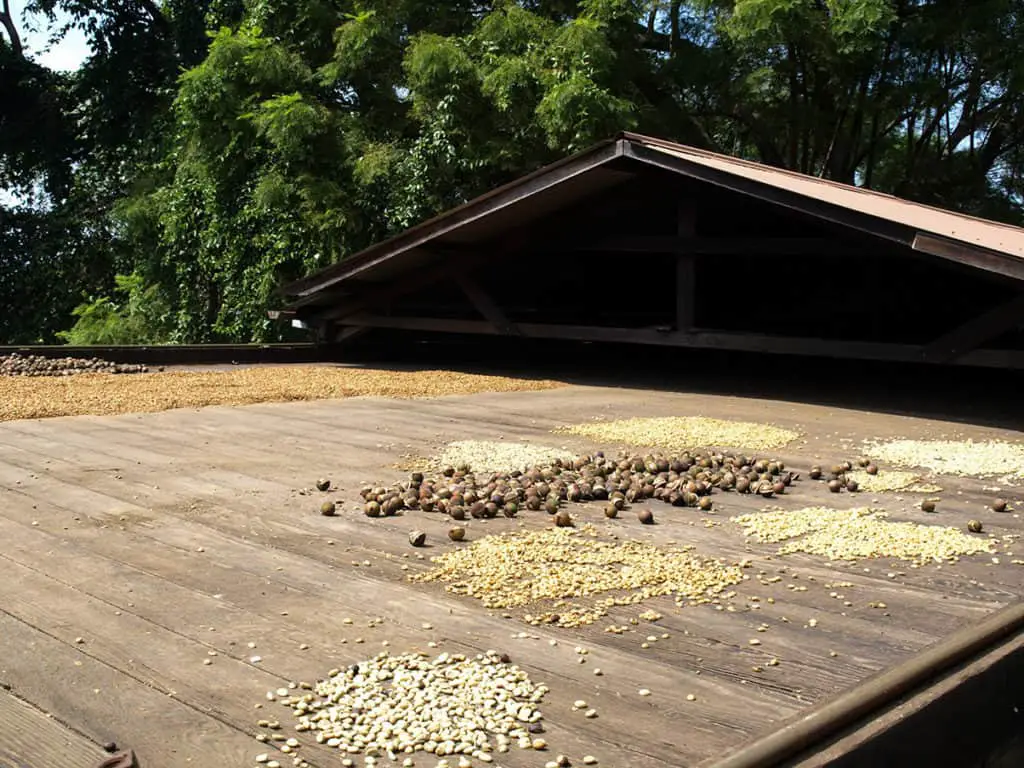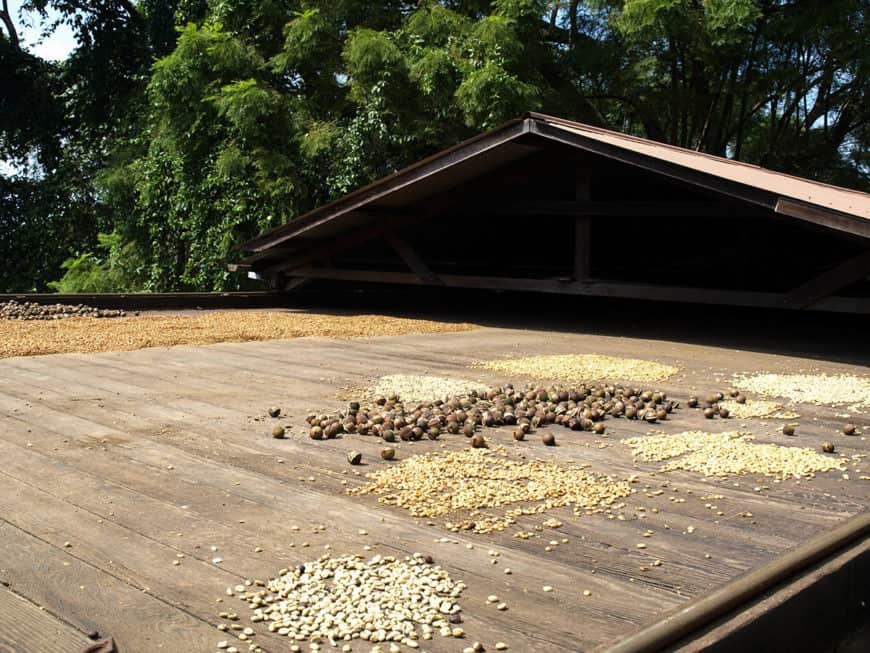
Giling Basah, semi washed or the wet-hulled coffee process it is more commonly known is done in places with high humidity and is where the seeds parchment layer will be removed before the seeds are fully dry. This type of coffee is produced almost exclusively in Indonesia.
Are you the type of person that loves distinct tasting coffee? Have you hear about wet hulled coffee, but you’re unsure what to expect? Well, be sure to keep reading and you can find out what its like to have a cup of wet hulled coffee and if you will want to go ahead and brew a cup for yourself.
In this post, we are going to introduce you to wet-hulled coffee, and talk a little bit about why it is produced this way. If you are a coffee lover, then this information is important.
The Origins of Wet Hulled Coffee
As we said before; wet-hulled coffee is unique to Indonesia. This isn’t because Indonesia really wanted to do something ‘different’ to everybody else. It is more the fact that the unique climate of Indonesia means that wet-hulled coffee is a lot easier to produce.
The problem with growing coffee in Indonesia is the fact that it is a very humid environment. It also doesn’t get as much sun as other parts of the world. In fact, on some days, a coffee farmer would be lucky to get a few hours of sun to dry out their coffee beans.
This combination means that drying out coffee is difficult. It would take an exceedingly long time to dry out coffee in the ‘normal’ way. In fact, in some cases, it may be nigh on impossible to do that. This means that the whole process of wet-hulled coffee has been designed around drying out coffee beans as much and as quickly as possible.
In fact, the whole process can take a fraction of the time it takes to produce normal coffee. Many coffee farmers will only have wet-hulled coffee kicking around on their farm for a couple of days maximum. It is then sold on. Normal coffee farmers may have their coffee beans drying out for months on end.
Wet hulled coffee also has the benefit of ensuring that coffee farmers get paid quickly. This type of coffee is often produced by the smaller farmers in Indonesia, and they rely heavily on having a fast income.
So, the quicker they are able to dry out their coffee beans, the faster they can get paid. It probably helps that it takes a lot less work to produce this type of coffee too.
How is Wet Hulled Coffee Made?
The whole process of wet-hulled coffee has been designed to be as fast as possible. A lot of the parts of the production process are not all that different from standard coffee production. They are just…faster.
The first stages are not that different from standard coffee production. In fact, they are exactly the same. The coffee farmer has three jobs:
- Remove the skin from the coffee
- Leave the coffee beans to ferment overnight
- Dry the coffee until it is about 50% moisture content
At this point, the farmer’s work is done. The coffee beans will be taken to market, and then they will be sold on to the next stage of the processing. If you head to an Indonesian food market, you will often see several auctions taking place for these coffee beans. They are often snapped up rather quickly.
The next part of the process involves the coffee mill. Before they do anything, they are going to let the coffee bean dry out a little bit more. They want to get it down to 30% moisture content.
At 30% moisture content, the parchment of the coffee bean will be removed. A good proportion of the coffee beans will be destroyed or severely damaged at this point, although a lot of them will be kept in the mix. It is part of the reason why this type of coffee tastes so unique.
With the parchment removed from the coffee bean, it can now dry a whole lot faster. The aim of the mill will be to get that coffee bean down to 12% moisture content, and it is drastically fast.
Now, of course, because there is no parchment on the bean at this point, it becomes a lot easier for it to be contaminated. This is why the drying mill will be so important for the flavor of the bean. Some are drying their coffee out in less-than-fantastic areas.
Once that is all done (and this process takes about a month), the coffee is ready to be sold and to make a delicious (sometimes) cup of Indonesian coffee!
What Does Wet Hulled Coffee Taste Like?
The taste is incredibly unique. The flavor of wet-hulled coffees will taste vastly different depending on who is producing them. However, these beans are not going to produce your ‘normal’ cup of coffee.
For starters; wet-hulled coffees will not be as sweet. This means that people will often need to add a touch of their own sweetness to the coffee in order to more easily be able to drink it.
It won’t have the coffee aroma either. Well, not as strong. This can actually detract from the taste quite a bit. After all, we all know that taste can be influenced by smell.
Perhaps the key part about the flavor profile of this coffee, however, is that it is not as acidic. The flavor also has a lot of body to it. The result can be a coffee that is quite ‘heavy tasting’, but also, unlike any other coffee that you have tasted before. Honestly, it is tough to explain, because this coffee has such a unique taste.
Pros and Cons of Wet Hulled Coffee
A lot of the benefits of wet-hulled coffee are not for the drinker, but for the actual producer of the coffee. As we stated before; this is a fast process of producing coffee.
This means that coffee farmers can make money quicker from their coffee harvest. It also means that Indonesia, a country with a climate that isn’t really suited to coffee production, can actually produce coffee. It helps a lot of farmers live off their land.
You should also remember that wet-hulled coffee has quite a unique taste. A lot of people who are fans of Colombian or Kenyan coffee absolutely loathe the taste of wet-hulled coffee. This is why coffee farmers outside of Indonesia do not produce coffee in this manner. It isn’t liked by most people outside of Indonesia.
That being said, when it comes to flavor, it can be interesting to sample different wet-hulled coffees. Because the coffee is dried without the parchment, various flavors can enter into the coffee bean. Some of these good, others not quite so much.
There is no real uniform taste, and wet-hulled coffees can taste drastically different depending on where they were harvested, who dried them, whether the drying equipment was working properly, what the floor has been contaminated with, etc. etc. Some people enjoy this experience.
In fact, the unique taste of wet-hulled coffee means that it may be perfect for those who generally do not like standard coffee. This is something that we have seen quite a bit, actually. The flavor profile is just different enough for people to enjoy.
Final Thoughts
I cannot say with confidence that you will love wet-hulled coffe, and in fact, many people do not. However, if you are a coffee lover, you are urged to try it at least once. It is great to get a feel for how different coffees taste. Who knows, you may end up finding a wet-hulled coffee that you do love!

